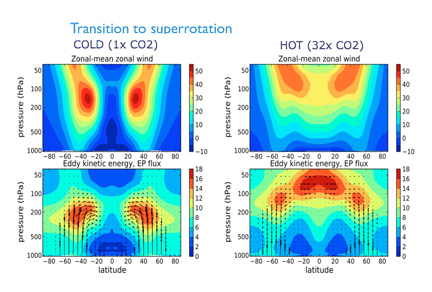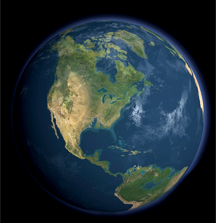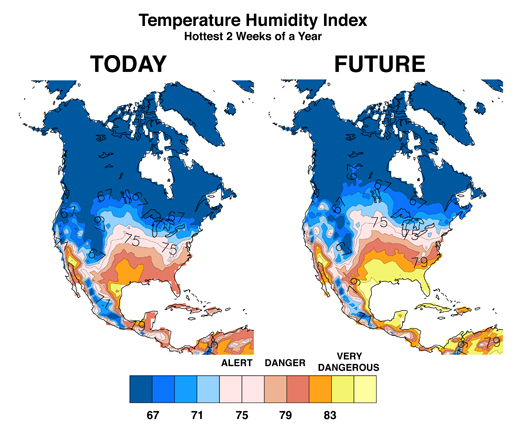Fall 2013
Earth Systems Science
might lie ahead
IT WASN'T UNTIL I LISTENED to the first interview with Matt Huber I recorded for this story that it dawned on me: I knew this voice, knew its distinctive delivery, and it didn't belong to Huber. I was listening to Richard Dreyfuss as the marine biologist in the movie "Jaws."
Huber was an audio Dreyfuss doppelgänger with the same measured enunciation, throaty tone, and rising-falling inflection. There was even a hint of the actor's signature, congenial brashness and wry, ready sense of humor. A quick look at the film verified all this and, it turns out, the marine biologist's name is Matt Hooper.
 |
|
| Matt Huber Photo by Anne Huber. |
It gets weirder.
After reviewing the story prior to publication, Huber told me that his uncle—writer, actor, and director Carl Gottlieb—co-wrote the screenplay for "Jaws" with author Peter Benchley, and is a longtime pal of Richard Dreyfuss.
Our scientist arrived early this semester at the Earth Systems Research Center and Department of Earth Sciences from Purdue University where he co-founded and served as director of the Purdue Climate Change Research Center. A paleoclimate modeler whose primary work is running vast general circulation model climate simulations aimed at understanding future climate, Huber still "plugs in" to the supercomputer at Purdue from his laptop—preferably, while sitting in a nearby café or coffee shop.
If you come looking for Huber in his third-floor, Morse Hall office, more often than not you'll come away empty-handed.
"Says Huber, "Historically I've always worked in coffee shops because it helps keep you integrated into the stream of life, and that helps academics stay grounded, I think. It also makes me and my postdocs and students very accessible."
"And my students know that if we're going to work in the café they have to buy coffee or something every couple of hours to pay the rent. So if it's me, a postdoc, and three grad students, that means daily my group is throwing something like $50 into the local café's pocket," Huber says with a grin and Dreyfussesque laughter. "I know it sounds silly but I consider this sort of activity important, especially for an employee of the state. Engagement with society at all levels is vital. This can be done in many ways but I feel it is important to be connected with the local community and with students."
Huber's work probes the deep-time of Earth's climate history, which means it takes time; a typical model run churns away for one to three years before there's any output to analyze. In the interim, he and his team go through the data from the last years-long simulation, which generates a terabyte of data per day or roughly the equivalent of 1,000 copies of the Encyclopedia Britannica. That's a lot of data pored over, and a lot of coffee poured.
He was hired in part with funds from UNH's large National Science Foundation EPSCoR (Experimental Program to Stimulate Competitive Research) project that began two years ago and involves many EOS researchers and other scientists across campus and around the state. Among other things, the NH EPSCoR "Ecosystems and Society" project is aimed at better understanding complex interactions among climate, land use, ecosystem function, and society.
As NH EPSCoR associate director and UNH professor of environmental and civil engineering Kevin Gardner notes, the number one goal of the EPSCoR program is to build research capacity and, by landing Huber, UNH hit a homerun.
"Matt brings a skill that nobody here has but many need," Gardner says. "He'll be able to provide a bridge between a lot of different research groups and greatly strengthen our abilities when going after significant proposals. His hire was about being able to collaborate across campus and go out and do new things, so it truly does extend our research capacity."
 |
|
| Created by one of Huber's modeling runs, the graph depicting east-west winds shows a transition from an Earth-like atmosphere (left) of today to extremely hot, carbon dioxide-rich Venus-like atmosphere dynamics (right) with equatorial superrotation—in which winds blow faster than the planet rotates. Although this graph represents conditions more than 50° F (10° C) warmer than what they are today, modeling suggests that such a condition could occur with carbon dioxide levels just four times current levels. Read more detail on enlarged linked image. Courtesy of Matt Huber. |
What follows is the first of a two-part story introducing Huber and his research. He received his Ph.D. in 2001 from the University of California Santa Cruz and arrives at UNH with an international reputation for work studying Earth's past warm climates, in particular the greenhouse climates of the Paleogene Period some 60 to 30 million years ago.
The Q&A format is unusual for Spheres but works well here given the depth of the subject at hand and Huber's penchant for diving deep, and long.
As we neared the conclusion of our second, extended interview, he paused, looked me in the eye and asked, "You tired yet?" After a good belly laugh he added, "You should never ask a professor to talk about him or herself, they don't know how to stop. 'Let me tell you more about how interesting I am…' Of course, when I go home and my wife asks how my day was I say, 'Fine.'"
Spheres: Your primary work is large-scale, supercomputer paleoclimate modeling using a general circulation model, or global climate model—something no one here does. How do you see that propelling EOS-UNH climate research forward, and what are aspects of smaller-scale modeling currently being done here that can be "plugged into" your modeling efforts, potentially to the benefit of both?
Huber: A lot of my work is paleoclimate, but all of my paleo work is targeted toward thinking about the future, so one of the threads I've always worked on has been modern climate. I believe our understanding of modern and future climate is only as secure as our understanding of past climate. It's risky to predict future global warming without testing climate models of the past, and I find it unsettling that the warm climates that dominated the past 90 million years are poorly understood—especially since that's where we appear to be headed.
In terms of me being a GCM modeler, even in the brief conversations I've had with people here, that seems to be the missing element in a lot of their proposals and papers and graduate student education. A lot of these various research initiatives seem to be lacking someone with expertise in and capability of modeling the global climate system. I hope to fill that gap. There are people here who use output from GCM models, and scientists who do weather and glacial and ocean modeling, but having someone who does global, coupled ocean-atmosphere modeling is a new thing.
The modeling I do uses very large, sophisticated numerical codes and the models are global in extent. They include atmospheric dynamics, atmospheric processes, a global representation of ocean processes, a land surface model, which includes vegetation, and a sea-ice component as well.
These models have grown from representing just the physics of the climate system to being what we call Earth system models. They now include biogeochemical cycles and vegetation interaction, so plants actually grow in the model and live and die and there's actual succession. And in the ocean, we have plankton that float around and are eaten by animals in the ocean. We have simple representations of ecosystem feedbacks and chemical interactions as well.
So the models have come to really encompass, at least in a very coarse way, all aspects of the Earth system. But when you start getting down to finer scales or more detailed problems, that's where these big models are not useful by themselves and require coupled work with smaller-scale models, which is exactly what we plan on doing here.
Spheres: Couldn't this have been achieved to some extent through collaborations while you were still at Purdue?
Huber: 'Long-distance' collaborations are good but it's always better to have the person there because people benefit from one-on-one, face-to-face interactions, that's where you get your really great ideas.
Ideas where you really knock the ball out of the park come from long-term relationships with people. This provides opportunities and could be, for example, the result of a chance encounter in the hallway, a conversation over a latte, teaching a class with someone, or co-advising a student. That's often where really new and exciting things happen. It's like the peanut butter-chocolate thing, which isn't likely to happen on the phone or by email.
Spheres: You say that the big GCM models are not useful "by themselves" when you start getting down to finer scales or more detailed problems. So what is it that you do to make them more "useful"?
Huber: At the large scale, you can only get a very poor representation of reality. For example, if you represent the entire Gulf of Maine as one grid cell in the model and all ocean ecology as being an interaction between three idealized forms of life—nanoplankton, zooplankton, and detritivores—and if you want to predict how local fisheries are going to behave, the model could tell you some very general things but it would be a lousy way to make quantitative, useful predictions at the kind of scales that matter to people.
An important aside here: note that in these big models we don't have cod or lobsters swimming around the Gulf of Maine, we just have some very generic thing that eats other things that swim around in the model. And there's not really a "they" and they don't really "swim," there's just one giant "beast" in each grid cell that "eats" everything that falls through the water column.
The same thing goes for trees. We do have the physics and chemistry and biology of trees represented in GCM models by what are called "plant functional types"—an awful thing that exists only in model world. There are no maple or pine trees. The model would be capable of telling you that, as climate changes, maybe you lose the "temperate deciduous trees" and maybe the "needle-leaf evergreens" become more dominant. But if you're in New England you care whether it's a maple or pine that's taking the hit.
This is where there's a lot of room for the kind of interaction between my expertise with these global models and the people who work at finer scales or on more detailed aspects of the dynamics of ecosystem interactions. They may be able to take the large-scale output of my physical models, and use that to drive much more detailed process-based models. So they could say, "Huber's model predicts there will be fewer temperate deciduous trees but we can actually say there will be fewer maples."
In a case like this we're bridging a gap, and that's one of the main areas I'll be working towards here. I'll admit that it's relatively new to me, and it will be challenging, but that's really what we need to be able to do.
 |
Spheres: On that note, how do you see your paleoclimate modeling work meshing with the EPSCoR Ecosystems and Society project, which has a much smaller-scale, regional focus and seeks to link empirical science with relevant societal needs?
Huber: I directed the Purdue Climate Change Research Center—a multidisciplinary, cross-college research center with over 60 affiliated faculty members. One of main goals of the lab was to bridge gaps between the physical climate system, ecosystems, and society. So I was really happy to see that UNH got a large grant to do precisely that. To me, it seems exactly the right direction for research at a university to be going.
And I don't think I'm unique in thinking this, there's widespread recognition that the pie-in-the-sky science has been done. Some of that should still be done, of course, there's always a need for fundamental research, but at some point you have to make it relevant to people, especially since it's the people who pay for us to do this. So we need to think seriously about making our science relevant to people in their daily lives.
On a personal note related to this, my mother is a nurse, teacher, and ethicist. She ran an AIDS hospice in 1980s and works on the 9/11 First Responder Task Force following up with them on health issues. When I was in college getting interested in science she said to me, "All this stuff is good but at some point you should actually help people."
Ever since I was 19 and working on past climate change, I actually had a feeling that it might seem completely irrelevant and, at the time, it truly was. The issue was simply not on anybody's radar as important, it was not in the newspaper everyday, wasn't this wildly divisive topic that affects global economy and launches debates on right and wrong.
Over the last 20 years, the science I do has transitioned from being more or less irrelevant to modern society to something we very much need to understand and translate the important results we get into things that people can actually use, things that can help inform improved building codes or better decisions about storm water management, for example. Which is where things start to get really interesting and, frankly, much more challenging, because if you do what I do for a living, you know the models have very large uncertainties, large error bars.
The EPSCoR project was designed and implemented without me and the modeling capabilities I bring, and the real question is, now that I'm here and interacting with all sorts of people and learning things, what happens next? I don't know, it'll be exciting, but I anticipate we'll take things and go in new directions—new for me and new for other people here.
Spheres: Do you think the EPSCoR project is flexible enough for you to plug into with relative ease?
Huber: One bit of serendipity is that a number of the elements of the Ecosystems and Society program mirror things I'd already started doing in my research program at Purdue. So as both a researcher and director of the climate center, I had been engaging in and facilitating this dynamical downscaling that's central to the EPSCoR project—that is, taking global model output and using that to drive high-resolution, limited-area models of weather and land surface hydrology and vegetation. This is something I'd transitioned to doing a number of years ago as well as trying to facilitate getting other people to do that.
So it's actually very natural to take this thread and weave it in here because, as it turns out, that's exactly what people need me to be doing. It will be pretty much plug and play. But there's always just the social issue of linking up, you know, "Hey, I'm here now and here's what I can do. Find me or I'll find you, put me on that mailing list."
Spheres: Or better yet, just mosey down to the local java joint, share a cup a joe and, perhaps, break some new ground.
In the next issue of Spheres, Huber will talk more about the particulars of his paleoclimate work in the hot-Earth Miocene and Eocene epochs, the inherent insensitivity of models to levels of carbon dioxide, and, related to the latter, the ethical dilemmas of reporting model results with known, large uncertainties. And we'll introduce post-doctoral scholar Nick Herold, Huber's colleague who has also arrived from Purdue.

